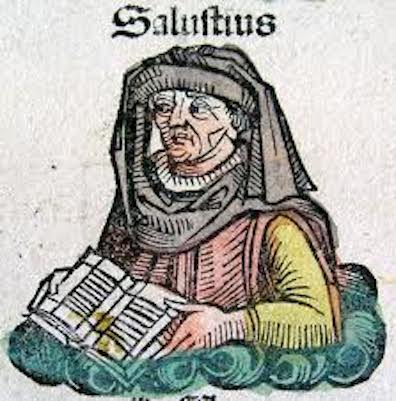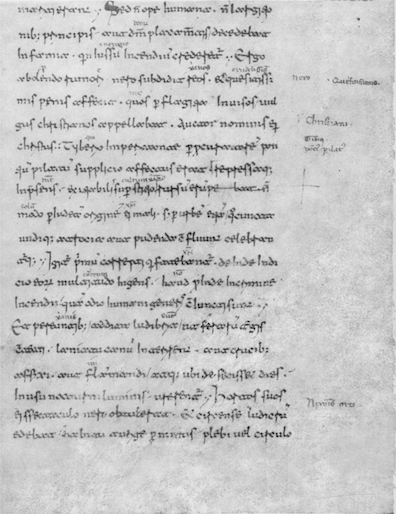In a letter to his friend Frank Budgen on 20 March 1920,
Joyce reported that he was "working hard at Oxen of the
Sun, the idea being the crime committed against
fecundity by sterilizing the act of coition." The chapter, he
wrote, would parallel the stages of human embryonic
development and "the periods of faunal evolution in general"
by presenting an historically arranged sequence of English
prose styles, "introduced by a Sallustian-Tacitean prelude
(the unfertilized ovum)." The paragraph discussed here appears
to constitute the prelude he was talking about. Sallust
(86-ca. 35 BCE) and Tacitus (ca. 56-ca. 120 AD) were Roman
historians. Why Joyce should have looked to these ancient,
non-English writers as he began recapitulating the historical
development of English prose is a mystery, though Tacitus did
write extensively about the Germanic peoples who later settled
in Britain, and some people think he may have been a Celt.
Nor is it at all clear (to this poor Latinist, at least) how
the prose of the two historians could have inspired Joyce to
compose the magnificently involuted gobbledygook of his first
paragraph. Tacitus wrote clearly and sparely. Even when his
sentences are lengthened by subordinate clauses and parallel
verbs, his aim is always to describe a situation as
economically and directly as possible. Sallust was known for
unusual diction (obsolete or rarely used words, innovative
phrasings, nonstandard spellings, strange conjunctions and
verb endings, neologisms), but he too preferred brevity to
Ciceronian ornateness.
Gifford supposes that the paragraph is an "imitation" of
Sallust and Tacitus, which seems hard to fathom, though he
qualifies the claim by affirming Stuart Gilbert's observation
that the prose sounds like a literal translation from Latin,
"without Anglicization of word usage and syntax." That much
seems plausible. The long sentences, with their disjointed
clauses, looping parenthetical phrases, and bafflingly
arranged modifiers, do feel like a poor translator's effort to
adapt the syntax of Latin to an uninflected language. One tiny
example: "the honourable by ancestors transmitted customs"
places words in an order that Latin case declensions can
accommodate but that wreaks havoc with English syntax. We
would instead say, "the honorable customs transmitted by our
ancestors."
The passage's use of obscure Latinate words where others
would better convey meaning to an English-speaker—acumen,
sapience, proliferent, benefaction, exhortator, and so
on—likewise suggests an effort to approximate the effect of
reading some kind of Latin. Several totally unfamiliar
Latinate words may even suggest neologism and archaism in the
manner of Sallust: "omnipollent" means
"all-powerful" (pollens, from polleo, "I am
strong"), and "lutulent" means "muddy,
turbid, thick" (lutulentus, from lutum, "mud").
Gifford identifies "irrevecund" as a rare
Latinate word meaning "immodest."
The paragraph's core assertions, wrapped within webs of
misdirection that Joyce evidently labored hard to weave, seem
to be somewhat as follows: In "no exterior splendour"
(no outward manifestation?) is the "prosperity of a
nation more efficaciously asserted" (economic
wellbeing should result in population increase? improvement in
citizens' lives?) than in its ways of showing "solicitude"
(care) for the condition of pregnancy, which is "omnipollent
nature's incorrupted benefaction." The "evangel"
(good tidings) of God's holy book gives us both "command and
promise" to be fruitful and
multiply, and so the "reiteratedly procreating
function" (making babies not just once, but
repeatedly) is "ever irrevocably enjoined" upon us. In the
past, our "nation excellently commenced" a tradition of
respecting this imperative (by having large families? by
honoring pregnant women?), and it is to be hoped that these
"honourable by ancestors transmitted customs" will be
perpetuated in the future. But some people today have an "acumen"
(intellectual keenness) that is not very "perceptive." Lacking
in "sapience" (wise understanding) of what,
rightly understood, requires "veneration," these
"inilluminated" ones do not see that every good citizen must
join in the cultural project, becoming "the exhortator
and admonisher" of his fellow citizens (urging them
to carry on the old wholesome traditions, and reproving those
who do not).
A considerable portion of this message can be summed up in
the immortal words of Monty Python: "Every sperm is sacred, /
Every sperm is great. / When a sperm is wasted, / God gets
quite irate." The theme of divine anger at the taking of life,
prompted by Homer's story of Odysseus' men killing the cattle
of Helios, starts here and continues throughout Oxen of
the Sun. The relevance of this message to the drama
acted out in the maternity hospital—where drunken and
blasphemous young atheists raucously celebrate sexual license
while a poor woman suffers through an excruciatingly prolonged
labor—is quite clear. The connection to Sallust and Tacitus,
however, feels extremely tenuous. Could Joyce, as he continued
working on Oxen, possibly have found some medieval
Latin text better suited to his purposes than the Roman
historians? Such a text, if one were found, might conceivably
account not only for the ungainly prose but also for the
Christian messaging.
Joyce wrote in a letter to Harriet Shaw Weaver that Oxen
of the Sun contained "nine circles of development," and
Robert Janusko has observed
that he worked in nine notebooks corresponding to the nine
months of gestation. But it remains an open question whether
the finished chapter creates such an effect with anything
approaching the dense specificity of its echoes of English
prose writers, and critics who have labored to associate the
various literary styles with the stages of pregnancy seldom
agree with one another on the particulars. Some styles do
suggest phases of organic development, however, and nowhere is
this more evident than at the beginning of the chapter.
Joyce's notion that his Sallustian prelude would correspond to
"the unfertilized ovum" seems as good an explanation as any
for its inchoate form.
The sprawling shapelessness was clearly part of his design.
The long final section of Oxen rivals the first one in
inchoate obscurity (though in no other way), and in the letter
to Weaver Joyce called these challenging sections "the
headpiece and tailpiece of opposite chaos." Some critics have
associated the final section with an "afterbirth"—the
placental remains of the developmental process—or with the
inarticulate cries of a newborn baby. The opening style gives
the impression of prose that has the potential to be
intelligible but has not yet realized its destiny.
My notes on the strange succession of styles in Oxen
will not wade very far into echoes of pregnancy, embryonic
development, and animal evolution. They will focus largely on
Joyce's echoes of various writers of prose. Here too, though,
a caveat is in order, since the chapter's different sections,
insofar as one can clearly distinguish them, do not allude to,
imitate, or parody those writers in any tidy way. Sometimes
Joyce appears to have drawn on multiple writers from a given
historical epoch, playfully aping the style of a period rather
than a person. And very often tidbits that he gleaned from
writers of different historical eras jump the bounds of
periodicity and appear out of place, reflecting perhaps simply
his freedom to write as he pleased, drawing on the words and
phrases that were teeming in his brain after immersing himself
in a huge variety of English prose styles.
Joyce was not so much imitating particular authors and works
as weaving a pastiche of loosely historical styles in response
to Peacock's anthology of literary examples and Saintsbury's
analytic treatise quoting such examples. As Weldon Thornton
observes in Allusions in Ulysses, that method makes
discussion of literary allusions problematic: "This episode
poses unique problems for an allusion study, since its style
echoes and recapitulates various English styles from
Anglo-Saxon literature to modern slang and evangelical
oratory, and since Joyce apparently used certain books on
English style and literary history as sources for some of the
material in the episode. Thus the line between an allusion to
a specific work and a parody of a period style is difficult to
trace, as is the difference between an allusion to a certain
work and Joyce's use of a source that may have included that
work" (323).
When Thornton was writing, Robert
Janusko was simultaneously studying the process by which
Joyce leafed through his anthologies, recorded phrases from
various authors on notesheets, and deployed his borrowings in
stylistic pastiches. This indirect engagement with other prose
writers resulted in countless echoes that Thornton could not
easily or in good conscience cite as allusions, but it did
produce nearly three dozen striking, quirky literary
style-portraits that together vividly evoke the historical
development of English prose. My chosen task, aided by
Janusko's genetic research, is to try to show how Joyce's
little prose poems both engage with earlier English writing
and advance his own narrative aims. Hopefully these notes may
also manage to suggest how much fun Joyce was having with the
possibilities of English prose.

